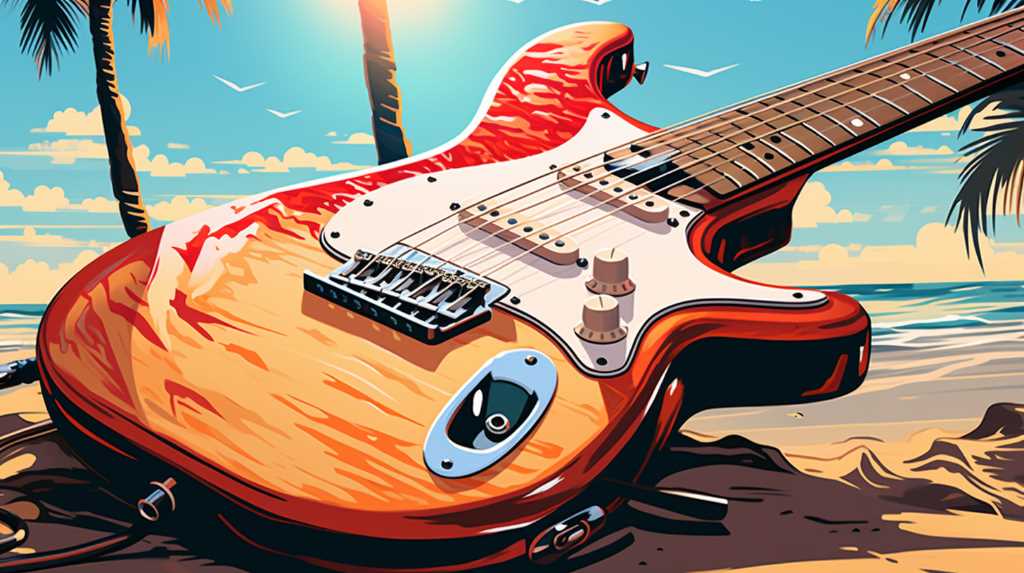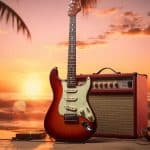
Surf music, with its vibes of sunny beaches and the laid-back life of the ’60s, still inspires guitar players today for its special sound and technical details. To really get surf music, you need to know its history and commit to learning the key gear and skills. The sound is marked by the echoing twang of an electric guitar, a strong bass groove, and a solid drum beat.
When we look at what makes the surf sound, like picking the right guitar and amp and nailing the classic pick-and-tremolo playing style, it’s clear that enthusiasts need to notice the little things that make a tune into a true surf hit. But remember, the fun vibes of surf music come with a level of complexity that might surprise skilled musicians.
To start playing surf music, you’ll need a guitar that can give you that iconic echo. A Fender Stratocaster or a Jaguar paired with a reverb-heavy amp like the Fender Twin Reverb can do the trick. Then, practice the pick-and-tremolo technique – it’s where you quickly alternate between picking a note and using the tremolo bar for that wave-like sound. This might seem simple, but it takes practice to get it right and make your music sound like the surf classics.
History of Surf Music
Surf music started in the early 1960s and quickly became the soundtrack of California’s beaches. It was lively and full of energy, much like the waves that surfers love. This music, which came from the West Coast, fit perfectly with the laid-back attitude of surfers.
The fast beats and the echo effect on the electric guitars made you feel like you were riding the waves yourself. Musicians like Dick Dale were important in shaping the sound of surf music. Dale was known for playing his guitar really fast.
Another band, the Bel-Airs, had a popular song called ‘Mr. Moto.’ Bands like The Ventures and The Surfaris created songs that spoke to young people and represented their desire to be free and different. For example, ‘Wipe Out’ by The Surfaris is a song that many people still connect with the excitement of surf culture.
Essential Equipment
To get the classic surf music sound, players need certain instruments and gear.
The main instrument is an electric guitar with single-coil pickups, which gives a bright sound. It often has a whammy bar to make the signature wavy sound effects.
A bass guitar is also important to keep a steady beat that surf rock relies on.
For the right echo effect, amplifiers with reverb are a must. They make the music sound like ocean waves. The Fender Reverb Tank is a popular choice because it has shaped the surf sound from the start.
Drums complete the band, with snares and tom-toms set to give a strong, yet not too sharp, beat that fits well with the smooth guitar tunes.
Mastering the Basics
To really get good at surf music, start by learning the basic techniques and rhythms that make this genre unique. Surf music is lively and echoes with a reverb effect, making fast picking and good timing essential. To get that classic ‘wet’ guitar sound, play around with your reverb effects until it sounds like you’re playing in a big, echoing space, like the beach scenes that inspired this music style.
Get the hang of the typical surf rhythm, which is a steady 4/4 beat with a noticeable hit on the snare drum. To really understand surf music, listen to famous bands like The Ventures or Dick Dale. Try to copy their catchy, short melodies and the way they pick their notes quickly.
Remember, mastering these skills means practicing them regularly. For example, you could set a daily goal to work on your picking speed or to fine-tune your reverb settings. It might also be helpful to use a metronome to keep your timing sharp.
And when you’re looking for musical inspiration, consider using a streaming service to create a playlist of surf music classics to immerse yourself in the genre.
Surf Guitar Techniques
Exploring surf guitar, you’ll quickly learn about the special tricks that make its sound unique. The vibrato arm, also known as the whammy bar, wobbles the guitar strings to create a sound similar to ocean waves.
Fast alternate picking makes a strong beat that’s like the steady crashing of waves on a beach.
Double picking is when you hit the same note over and over really quickly, which brings a thrilling feel to the music, just like the rush of surfing a big wave.
These skills are important because they don’t just copy the feel of the sea; they also give the music its lively energy.
To play surf music well, you need to get good at these methods.
Practice and Progression
To get really good at surf guitar, you need to practice a lot. Start by learning how to make your guitar sound like the waves with lots of reverb. Work on the fast picking, shaking your hand to make a vibrato sound, and quick double picks, but do it in small steps. It’s important to get good at slides and quick note changes because they make the music sound smooth.
When you’re practicing, start with easy tunes and then try harder beats and chords as you get better. Recording yourself can help you see where you need to improve. If you keep at it, you’ll not only get better at playing the guitar, but you’ll also feel more connected to the whole surf rock scene.
Remember to set goals you can actually reach. This way, you won’t get overwhelmed. For example, you might aim to nail a classic surf riff like ‘Misirlou’ before moving on to something more complex. And if you’re looking for a good reverb pedal to get that surf sound, try something like the Fender ’63 Reverb or the Boss FRV-1.
Conclusion
Surf music is a special type of music that reminds us of the beach and surfing. If you want to play surf music, you need the right instruments and you have to practice a lot. It’s important to learn how surf guitarists play and how their music is supposed to sound. When you practice a lot, you get better and can even add your own style to the music.
For example, to get the classic surf music sound, you might want to use a Fender Stratocaster guitar because it has a bright, twangy tone that fits the genre well. Also, using a reverb effect pedal can help recreate the echoey sound that’s a big part of surf music.
Remember, practicing the quick picking and the steady drum beats of surf music will help you get the hang of it. Keep practicing, and you’ll be able to play music that makes people think of the ocean and sunshine.








